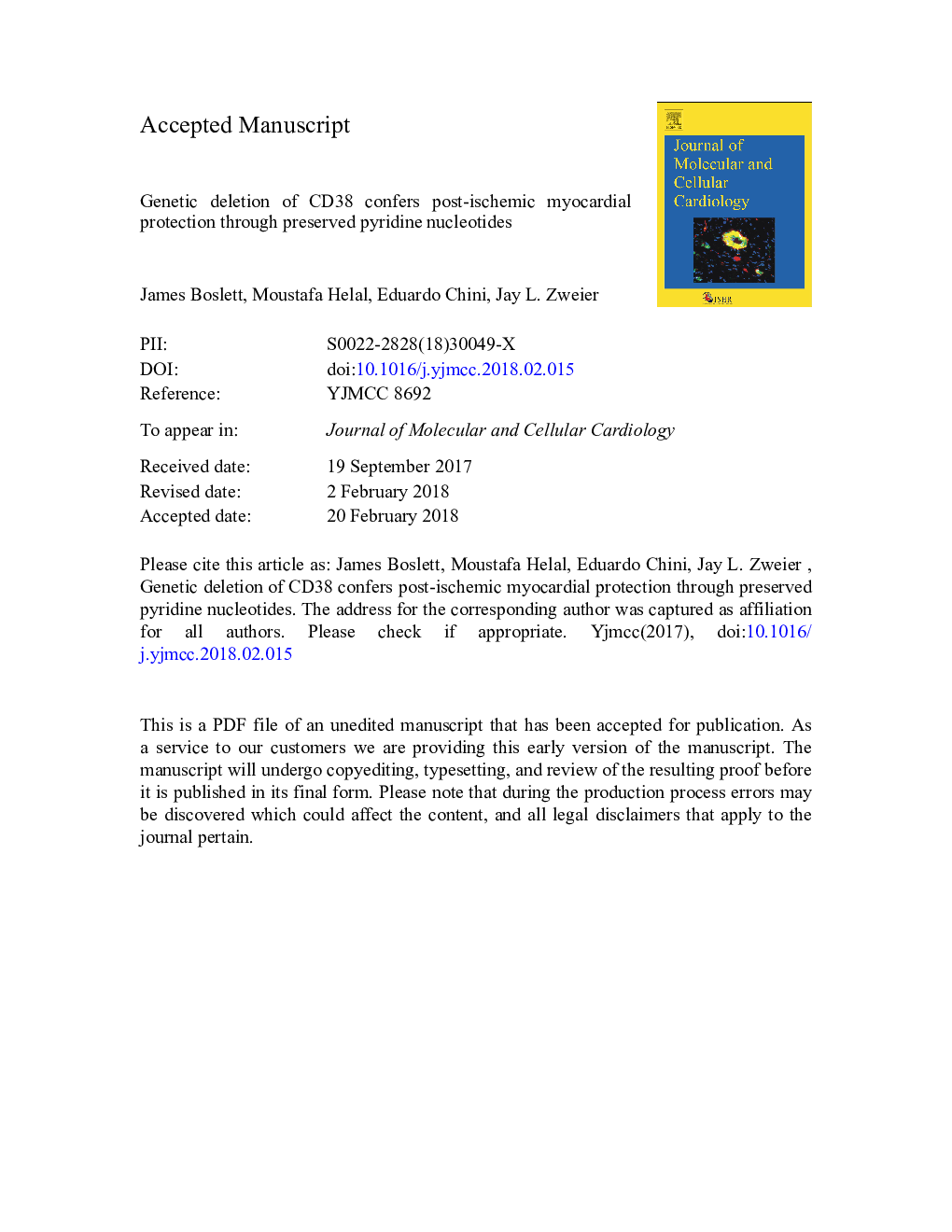| Article ID | Journal | Published Year | Pages | File Type |
|---|---|---|---|---|
| 8473428 | Journal of Molecular and Cellular Cardiology | 2018 | 53 Pages |
Abstract
Following the onset of ischemia/reperfusion (I/R), CD38 activation occurs and is associated with depletion of NAD(P)(H) in the heart as well as myocardial injury and endothelial dysfunction. Studies with pharmacological inhibitors suggest that the NADP+-hydrolyzing ability of CD38 can deplete the NAD(P)(H) pools. However, there is a need for more specific studies on the importance of CD38 and its role in the process of endothelial dysfunction and myocardial injury in the post-ischemic heart. Therefore, experiments were performed in hearts of mice with global gene knockout of CD38. Isolated perfused CD38â/â and wild type (WT) mouse hearts were studied to determine the link between CD38 activation, the levels of NADP(H), endothelial dysfunction, and myocardial injury after I/R. Genetic deletion of CD38 preserves the myocardial and endothelial NADP(H) pools compared to WT. Whole heart BH4 levels in CD38â/â hearts were also preserved. Post-ischemic levels of cGMP were greatly depleted in WT hearts, but preserved to near baseline levels in CD38â/â hearts. The preservation of these metabolite pools in CD38â/â hearts was accompanied by near full recovery of NOS-dependent coronary flow, while in WT hearts, severe impairment of endothelial function and NOS uncoupling occurred with decreased NO and enhanced superoxide generation. CD38â/â hearts also exhibited marked protection against I/R with preserved glutathione levels, increased recovery of left ventricular contractile function, decreased myocyte enzyme release, and decreased infarct size. Thus, CD38 activation causes post-ischemic depletion of NADP(H) within the heart, with severe depletion from the endothelium, resulting in endothelial dysfunction and myocardial injury.
Keywords
TTCPTBP1SPEGSHLVEDPHRPLVDPcGMPrPPGSSGDTPAeNOSSIRTBH2KOHTBSTSGCBH4tetrahydrobiopterinNAADPNH4OHTRISSDSPPCKH2PO42,3,5-triphenyltetrazolium chlorideBSAdhfrI/RKCNl-NAMENω-nitro-l-arginine methyl esterROSbovine serum albuminAmmonium hydroxideEDTAEthylenediaminetetraacetic acidSolid phase extractionOxidant stressnicotinic acid adenine dinucleotide phosphateEndotheliumIschemiaischemia/reperfusionIHCImmunohistochemistryleft ventricleTris(hydroxymethyl)aminomethaneSPRcoronary flowDiethylenetriaminepentaacetic aciddihydrobiopterindihydrofolate reductasesodium dodecyl sulfateendothelial nitric oxide synthaseSepiapterin reductaseSoluble guanylate cyclaseHeart ratephosphatidylcholineRate pressure productcyclic guanosine monophosphatesodium nitroprussideNitric oxidepotassium cyanidepotassium phosphatePotassium HydroxideHorseradish peroxidasepolypyrimidine tract binding proteinSNPreduced glutathionecoronary circulationoxidized glutathioneReactive oxygen speciespotassium iodide
Related Topics
Life Sciences
Biochemistry, Genetics and Molecular Biology
Cell Biology
Authors
James Boslett, Moustafa Helal, Eduardo Chini, Jay L. Zweier,
